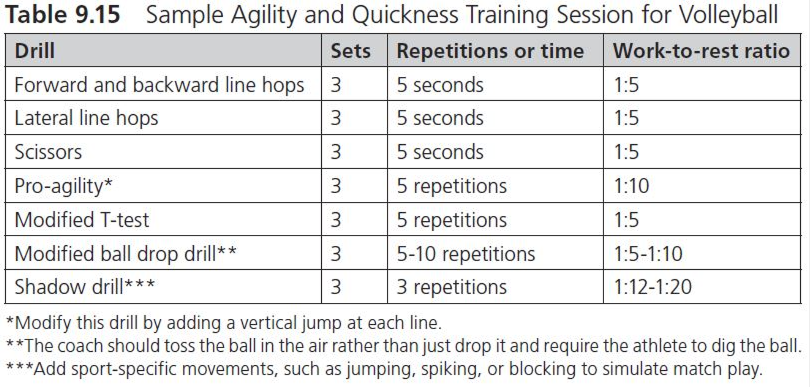Volleyball
by Developing Agility and Quickness
Kinetic Select
November 2023
This excerpt from Developing Agility and Quickness aims to provide a snapshot of programming volleyball-specific agility and quickness sessions.
The following is an exclusive excerpt from the book Developing Agility and Quickness, Second Edition, published by Human Kinetics. All text and images provided by Human Kinetics.
The sport of competitive indoor volleyball uses a player rotation design. The positions within the sport consist of one setter, two middle blockers, three outsider hitters, and a libero who is a backcourt defensive specialist. There are six athletes on the court during each point. A predominance of jumping in volleyball occurs in the front court with the performance of attacking spike jumps and defensive blocks. Based on the size of the court, and the number of players involved, the ability to change direction over relatively short distances (i.e., within a 3- to 5-meter [3.3-5.5 yd] radius) is essential. Additionally, setters must execute jump sets and there are defensive diving efforts displayed throughout a match (9, 10) that require excellent perceptual and decision-making skills.
Volleyball requires speed, agility, and upper- and lower-body muscular power to be successful (2, 10). In general, volleyball players must perform repeated maximal or near-maximal jumps, frequent CODs, and repeated overhead movements when blocking or spiking (4). Based on these demands, it would appear that a volleyball player’s performance may be enhanced by improving technique for sport-specific and general movement skills, movement efficiency, and the ability to generate explosive power. For this reason, a training program aimed at improving agility for the volleyball athlete should address each of these areas.
Several studies have reported a significant relationship between speed, agility, and jumping performance (1, 5, 6, 7, 9). Since both jumping and COD ability are critical elements of this sport, incorporating jumps and landings in a volleyball-specific agility and quickness program makes logical sense. This approach allows both agility and power to be developed in the same training session.
When developing an agility training program for the volleyball athlete, there are several programming variables the coach should consider. As previously mentioned, the volleyball court dimensions are relatively small compared to other sports played on a court, such as basketball or netball. The coach should therefore look at the average distances traveled by a player and prescribe and adjust drills accordingly. For example, when comparing the standard T-test to the modified T-test, it appears that the modified version may more closely replicate the distance a volleyball player has to cover during a game. Additionally, the coach may also want to consider modifying the distances recommended for many of the tests and traditional agility drills featured in chapters 5, 6, and 7 to more appropriately meet the requirements and demands of volleyball players. Drills to improve foot speed and kinesthetic awareness that involve smaller dimensions (e.g., ladder drills, line drills, dot drills) may also be useful for improving quickness and movement time for the volleyball athlete.
PROGRAM DESIGN
The following is a sample training session for an indoor volleyball player. As a basic guideline this program should be performed 2 or 3 days per week, on nonconsecutive days. Based on observation and current best practices, some recommended training volumes (sets × reps) and rest intervals have also been included in this training session. The number of repetitions to be performed in this sample session are both fixed (i.e., a set number of reps) and flexible (the number of repetitions completed in a given timeframe). This strategy allows athletes and coaches to adjust the volume of work performed based on the individual athlete’s capabilities. The work-to-rest ratios have been selected based on match play (short sets and longer rallies), and to primarily stress the phosphagen and glycolytic energy systems (3). However, coaches should also use their personal experience, monitor how their athletes are responding to each drill, and adjust the program according to the individual athlete’s ability and fitness level.
Table 9.15 provides a sample training session for volleyball.

In Developing Agility and Quickness, leading experts from the National Strength and Conditioning Association (NSCA) offer more than 130 drills, 12 agility and quickness tests, and 15 sport-specific training plans to help athletes gain a step on the competition. The book is available in bookstores everywhere, as well as online at the NSCA Store.
- Privacy Policy
- Your Privacy Choices
- Terms of Use
- Retraction and Correction Policy
- © 2025 National Strength and Conditioning Association